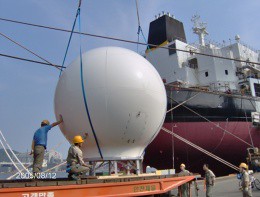Global Maritime Satcom

Reading Multichannel News (MCN) yesterday, I came across a "news item" about a new service from Intelsat, calling it a "Global Maritime Solution:"
Intelsat’s Network Broadband GLOBAL Maritime service differentiates itself from other offerings by incorporating two unique technical features. The first feature is an integrated Automatic Beam Switching system, which seamlessly transfers service between the satellites and maintains a site’s Internet session while the vessel is underway, eliminating the need for complex and costly manual intervention such as the re-pointing of antennas. The second feature, the platform’s Global Network Monitoring System, offers customers the ability to monitor all remote locations from a single monitoring site at any location desired by the customer. The requirements of companies managing vessel fleets and maritime infrastructures desiring efficient connectivity worldwide were the driving force behind these design features.
Not exactly a fine piece of investigative journalism here. Both the press release and MCN description have this identical morsel of text:
Utilizing Intelsat’s global satellite C-band capacity, the Network Broadband Global Maritime network operates at rates up to 2 megabits per second, with the initial service offering continuous communications with high-powered bandwidth rates from 128 kilobits per second-512 kbps. In addition, Network Broadband Global Maritime offers always-on broadband access that provides customers with continuous bandwidth for a fixed monthly fee.

C-band? That means me and my boat are gonna need to set aside some space on the poop deck for this little baby. We’re talking about a 10 to 12 foot diameter radome. For example, a Sea Tel Model 9797 ought to do it.
I don’t think the Intelsat satellites’ C-band payloads are hot enough to handle smaller antennas. Some of the newer, higher-power C-band satellites out there, such as GE-23, might be able to use smaller antennas. There was talk about using sub-2-meter antennas within "hotter" coverage beams (40+ dBW in downlink EIRP). In fact, the language in ST Electronics’ press release is remarkably similar to Intelsat’s, but I’m more interested in the 1.2-meter antenna they’re launching at CommunicAsia 2007 in Singapore:
The Agilis 1.2 metre maritime VSAT antenna designed and marketed by ST Electronics subsidiary, ST Electronics (Satcom & Sensor Systems) Pte Ltd, will provide smaller sea going vessels with an “Always On” connectivity for all their communication requirements. It provides not only secure transmission, but also a fast 512Kbps inbound transmission rate and up to 2Mbps for outbound transmission. Users can expect this cost-effective compact system to provide them with continuous on-board communications through a high performance network.
Recognising the potential in the large and untapped market base of smaller vessels, ST Electronics developed the antenna to provide these vessels an opportunity to benefit from efficient and cost effective broadband satellite communications. The antenna is considered as the smallest stabilised C-band antenna available in the market currently and will fit perfectly into the confined space of smaller vessels.
Wait a minute: we’re putting a puzzle together here. ST Electronics and VT Systems are part of the same company, and VT Systems bought in to iDirect Technologies. Based on their press release this week, it may be their platform and making this a real solution after all:
IndosatM2 (IM2), one of the largest Internet and multimedia service providers in Indonesia, announced today that it will offer satellite broadband service over Ku-Band using a universal satellite hub from iDirect Technologies. The expanded service follows IM2’s success in providing satellite broadband service over C-Band and enables IM2 to offer satellite broadband to thousands of small and medium enterprises throughout Southeast Asia in remote and unreachable locations, as well as to the consumer market.
Bringing all these technologies together is what it will take to weaken Inmarsat’s firm grasp of the maritime market.

